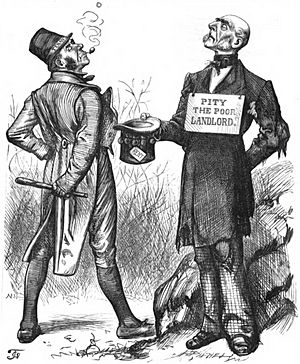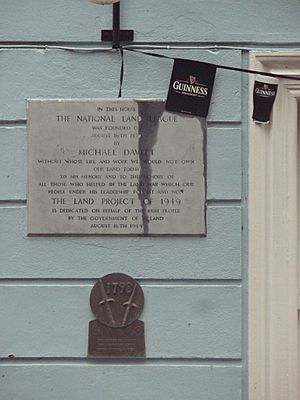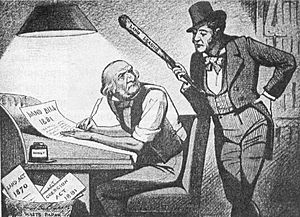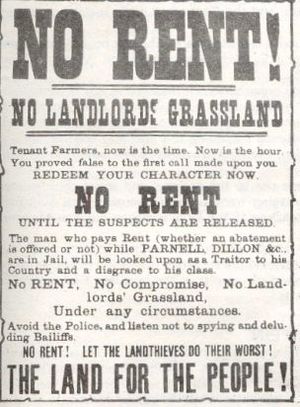Irish National Land League facts for kids
Quick facts for kids
Irish National Land League
Conradh na Talún
|
|
|---|---|

Irish landlord reduced to begging for rent, 1880 caricature
|
|
| Abbreviation | INLL |
| President | Charles Stewart Parnell |
| Secretary | Andrew Kettle Michael Davitt Thomas Brennan |
| Founded | October 21, 1879 |
| Dissolved | October 17, 1882 |
| Succeeded by | Irish National League |
| Ideology | Agrarianism Irish nationalism |
| Political position | Centre-left |
The Irish National Land League (in Irish, Conradh na Talún) was a group in Ireland in the late 1800s. Its main goal was to help poor farmers who rented land. They wanted these farmers to own the land they worked on. This struggle was called the Land War.
Contents
Why the League Started
Around 1874, the prices for farm goods in Europe went down. Then, for several years, Ireland had bad harvests because of wet weather. This was part of a bigger economic problem called the Long Depression. By 1878, many Irish farmers could not pay their rent. This was especially true in the poorer, wetter areas of Connacht. The famine of 1879 made things even worse for them.
Forming the Land League
The Irish National Land League was created on October 21, 1879. This happened at the Imperial Hotel in Castlebar. Charles Stewart Parnell was chosen as the president of the League. Andrew Kettle, Michael Davitt, and Thomas Brennan became honorary secretaries.
The Land League had two main goals:
- To stop unfair and very high rents. (The word "rack" here means a medieval torture device, showing how painful these rents were).
- To help farmers who rented land to eventually own the land they worked on.
Charles Stewart Parnell, John Dillon, Michael Davitt, and others traveled to the United States. They went there to collect money for the League. New groups of the League were also started in Scotland.
The government had passed the first Land Act in 1870. However, this law did not help much. Later, the Land Acts of 1880 and 1881 were passed. These laws created a Land Commission that began to lower some rents.
The League did not encourage violence. But, crimes still increased a lot during this time. Often, if farmers refused to pay rent, the police would evict them. Farmers who kept paying rent might be boycotted by their neighbors. This meant people would refuse to deal with them.
The Land League in America
A similar group existed in the United States. It was called the American Land League. This group collected hundreds of thousands of dollars. This money helped with famine relief and supported the League's political actions.
The Land War
From 1879 to 1882, the League led what was known as the "Land War". Its members strongly resisted evictions. They also worked to lower rents and helped relief groups. Their main demands were known as the "Three Fs":
- Free sale: This meant a farmer could sell their right to use the land to a new farmer. The landlord could not interfere.
- Fixity of tenure: This meant a farmer could not be evicted if they had paid their rent.
- Fair rent: This meant that rents should be controlled and not too high.
In 1885, the "Ashbourne Act" was passed. This law made it less profitable for most landlords to evict farmers. By then, farm prices had gone up again. Rents had also been set and could be lowered. Farmers found that working together was the best way to get what they wanted.
A new part of the Land War happened from 1886 to 1892. This was called the Plan of Campaign. The League would decide what a fair rent was. Then, they would tell their members to offer this rent to the landlords. If the landlord refused, the farmers would pay the rent to the League instead. The landlord would not get any money until they accepted a lower price.
Many landlords fought against these methods, often with violence. There were deaths on both sides of the conflict.
Because of the Land War, the government shut down the Irish National Land League. In October 1882, Parnell started a new group called the Irish National League. This new group worked on bigger issues, like Home Rule for Ireland. Many Scottish members formed the Scottish Land Restoration League. In 1881, the League began publishing United Ireland. This was a weekly newspaper edited by William O'Brien. It continued until 1898.
What Changed Because of the League
The Land War led to a series of Irish Land Acts. These were new laws about land.
The Land Purchase (Ireland) Act 1903 allowed Irish tenant farmers to buy their land. They could get loans from the UK government through the Land Commission. These loans had to be paid back over 68 years. This law finally helped solve the "Irish Land Question."
Later laws, like the Labourers (Ireland) Act 1906 and the Labourers (Ireland) Act 1911, helped build 40,000 new small houses in the countryside. Each house came with an acre of land. By 1914, 75% of farmers were buying their land from landlords. Most did this under these two laws.
In total, over 316,000 farmers bought their land. This was about 15 million acres (61,000 km2) out of a total of 20 million acres (81,000 km2) in the country.
See also




